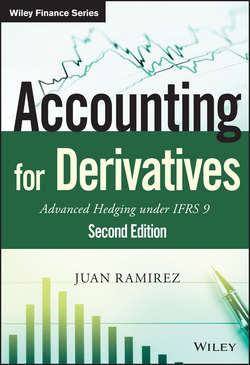Читать книгу Accounting for Derivatives - Ramirez Juan - Страница 14
На сайте Литреса книга снята с продажи.
Chapter 2
The Theoretical Framework – Hedge Accounting
2.1 HEDGE ACCOUNTING – TYPES OF HEDGES
ОглавлениеWhilst other instruments (e.g., a loan denominated in a foreign currency) may also be used, derivatives are the most common instruments transacted to reduce or mitigate exposures to market risks.
2.1.1 Derivative Definition
Under IFRS 9, a derivative is a financial instrument (or other contract within the scope of IFRS 9) with all of the following characteristics:
1. Its value changes in response to changes in a specified “underlying” interest rate, financial instrument price, commodity price, foreign exchange (FX) rate, index of prices or rates, credit rating or credit index, or other variable, provided in the case of a non-financial variable that the variable is not specific to a party to the contract.
2. It requires no initial investment, or an initial net investment that is smaller than would be required for other types of contracts that would be expected to have a similar response to changes in market factors.
3. It is settled at a future date.
Some commodity-based derivatives are not considered derivatives under IFRS 9. See Chapter 10 for a detailed discussion regarding which commodity contracts can be treated as IFRS 9 instruments.
2.1.2 Hedge Accounting
The objective of hedge accounting is to represent, in the financial statements, the effect of an entity's risk management activities that use financial instruments to manage market risk exposures that could affect profit or loss (or OCI in the case of equity investments at FVOCI).
Hedged Item and Hedging Instrument
In a hedging relationship there are two elements: the hedged item and the hedging instrument.
• The hedged item is the item that exposes the entity to a market risk(s). It is the element that is designated as being hedged.
• The hedging instrument is the element that hedges the risk(s) to which the hedged item is exposed. Frequently, the hedging instrument is a derivative.
For example, an entity hedging a floating rate loan with a pay-fixed receive-floating interest rate swap and applying hedge accounting would designate the loan as the hedged item and the swap as the hedging instrument.
Hedge Accounting
Hedge accounting is a technique that modifies the normal basis for recognising gains and losses (or revenues and expenses) associated with a hedged item or a hedging instrument to enable gains and losses on the hedging instrument to be recognised in profit or loss (or in OCI in the case of hedges of equity instruments at FVOCI) in the same period as offsetting losses and gains on the hedged item. Hedge accounting takes two forms under IFRS 9:
• Fair value hedge – recognising gains or losses (or revenues or expenses) in respect of both the hedging instrument and hedged item in earnings in the same accounting period.
• Cash flow hedge or net investment hedge – deferring recognised gains and losses in respect of the hedging instrument on the balance sheet until the hedged item affects earnings.
The following example compares the timing of the impacts on profit or loss when applying, or not applying, hedge accounting. Assume that an entity enters in 20X0 into a derivative to hedge a risk exposure of an item that is already recognised in the balance sheet. The derivative matures in 20X1 and the hedged item settles in 20X2. It can be observed that only the fair value hedge provided a perfect synchronisation between the hedging instrument and hedged item recognitions.
To be able to apply hedge accounting, the hedge must meet remarkably strict criteria at inception and throughout the life of the hedging relationship, which I will cover below.
2.1.3 Accounting for Derivatives
I mentioned earlier that all derivatives are recognised at fair value on the balance sheet, no matter whether or not they are part of a hedge accounting relationship. Fluctuations in the derivative's fair value can be recognised in different ways, depending on the type of hedging relationship:
• undesignated or speculative;
• fair value hedge;
• cash flow hedge;
• net investment hedge.
2.1.4 Undesignated or Speculative
Some derivatives are termed “undesignated” or “speculative”. They include derivatives that do not qualify for hedge accounting. They also include derivatives that the entity may decide to treat as undesignated even though they could qualify for hedge accounting. These derivatives are recognised as assets or liabilities for trading. The gain or loss arising from their fair value fluctuation is recognised directly in profit or loss.
